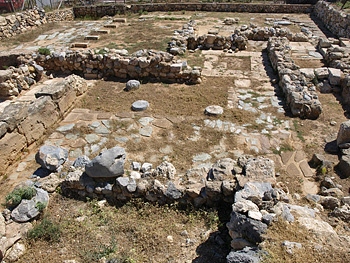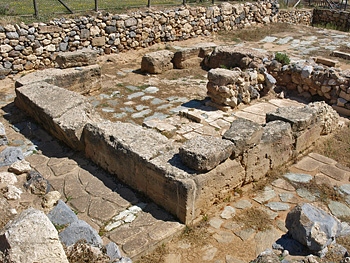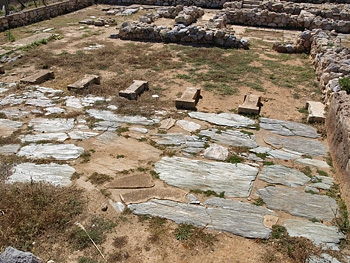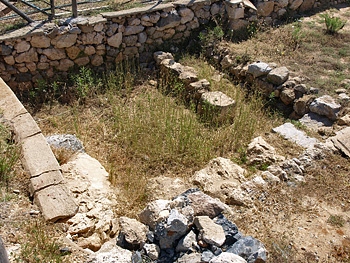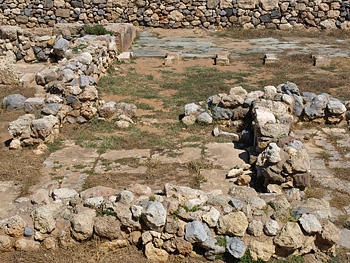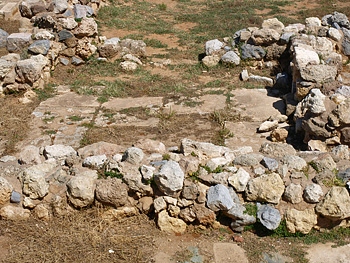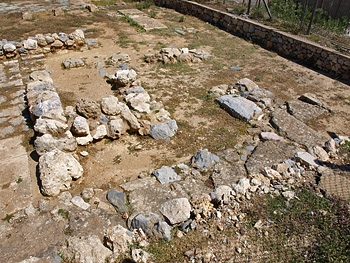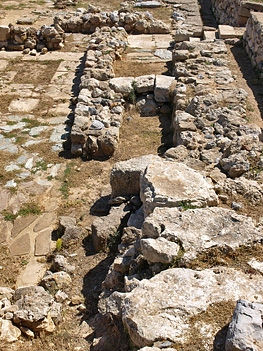The House of the Lilies
The villa of Amnisos is located in a small valley seven kilometres east of Heraklion and a few metres from a sandy beach about two kilometres in length. Immediately to the west there is a low hill. Although there had been talk of a seaport at Amnisos in classical times, repeated searches failed to come up with any evidence of a Minoan presence in the area.
However, efforts were redoubled after a Late Minoan rock tomb was found in the area and the excavation of the cave at Eileithyia showed that it had been in use from neolithic times onwards. The protection provided by the hill from the north west winds and the presence nearby of a river led Marinatos to excavate for the seaport. What he found was the neopalatial villa. On the last day of a trial excavation in the area Marinatos got two workers to open a trench on the eastern slopes of the hill and within an hour they began uncovering frescoes. Among the first fragments they examined were paintings of lilies.
The Minoan Hall
The villa is almost square and measures 20 metres by 20 metres and its orientation is a few degrees off a north-south axis. The villa had ten rooms on the ground floor and two floors. The rooms included a Minoan Hall, made up of an inner, larger room, (room 1 on the plan), while immediately to the north is the smaller hall, paved with schist slabs and separated from the larger hall by a pier-and-door partition. At the north end of this smaller room are two pillars that would have formed a small portico which would normally open onto a light well. It is not clear what lay to the north of the villa or whether the Minoan hall opened onto a light well or whether the building may simply have been open at this point.
In the south wall of room 1 of the Minoan Hall a doorway leads to room 6, which was also paved and which Marinatos identified as in part constituting a kind of sotto scala as a north-south staircase was found here with four preserved steps fallen but found in situ. The individual steps of this staircase present the usual triangular section, as seen end-on, of the Minoan "hanging" marble staircase. This shows that the steps would have been supported by two lateral wooden beams. The beams would have been held in place at the bottom on the south wall and fixed at the top on the north wall.
Room 7 was a large room on the west side of the building in which the bases of two pillars were found in situ. The room had an opening in the southeast corner into room 6. It was in room 7 that the wall paintings were found, piled up in a solid heap near the northern pillar base. In the northwest corner are two rooms, 8 and 9. The external walls here are constructed of ashlar masonry to a width of up to 2.20 metres. Marinatos speculates that in addition either the corners of the upper floor were constructed in stone or that possibly all the outer walls of the villa may have been constructed of ashlar masonry, including the walls of the upper floor since the quantity of fallen stones seemed to be too many simply for the ground floor.
There were two ways to access the upper floor. From the Minoan Hall it was necessary to pass through a doorway in the southeast corner leading to what was originally an oblong room 2, although a later internal wall divided the area into two (rooms 2 and 3). Marinatos originally thought that room 3 was some sort of porter's room. From room 2 one entered the corridor 4, where the use of hardwearing ironstone suggested to Marinatos that the corridor was well used. At the end of corridor 4 you reached a right angle turn connected to another corridor 5. The other way to access the staircase was from the south side of the building via three descending steps. These also brought you to corridor 5 and the site of the staircase to the upper floor.
The upper floor
Marinatos felt sure that the first floor room above room 7 would have been identical and its walls would have been decorated with the frescoes of red and white lilies, mint, iris and papyrus, which fell to the ground during the destruction of the building and were found on the last day of the trial excavation.
However, he felt rooms 8 and 9 might have been only one room on the second floor as the partition wall on the ground floor was not built to support an upper floor wall. Marinatos thought that room 1 of the Minoan Hall would have been repeated on the upper floor as a door jamb and schist paving stones from the upper floor were found. The floor above room 7 had been covered with tufa slabs while there was no evidence of an upper floor above rooms 2 and 3.
There was also a kitchen area, a bathroom and a shrine. Room 11 is thought to have been a lustral basin which may have gone out of use in the LM IA period.
The frescoes
The frescoes contained no representations of animals, only of various plants. Three main types of plant are represented. 1) Lilies which show an unprecedented style where the stalks and the flowers are presented in white and blue colours against a red background; 2) Lilies and irises painted in red and green on a white background; 3) Plants from the mint family in thick clusters on a wavy background that changes from red below to white above. A small piece also showed a cluster of crocuses.
The remaining pieces give us a good idea of the whole since combined they would have covered several square metres. The lilies alone cover an area more than 1.5 metres high by at least one metre wide. It would seem that the east wall was not decorated, the north wall was decorated with the lilies, and the west wall with the red irises and clumps of mint. The south wall was not complete like the same wall on the ground floor and may have depicted on a much smaller scale irises and the clump of crocuses. Marinatos believed that the lilies are the prototype of the vases with lilies from Knossos, belonging to the MM III period. Many similar vases of LM IA in the floral style took their themes from similar prototypes. The frescoes of Knossos and Ayia Triada are clearly of a more advanced style. Describing the difference in fresco styles Marinatos said of the later style that the flowers stand out for their greater liveliness and movement, spreading out with a graceful lightness on the surface. The frescoes of Amnisos, he suggested, dating as they do from an earlier period, are more spare and austere and the types of plants are more limited in contrast with the variety of the mature period while the choice of colours is also more restricted.
Chronology
On the basis of the evidence Marinatos came to the view that the villa had been built in early MM III. A number of mason's marks were found carved into the soft stone used in the building's construction. These included three examples of a trident, two examples of a star, two examples of an arrow and eight examples of a cross, all of which suggest a Middle Minoan origin. The few traces of pottery suggest Middle Minoan or Late Minoan, with a wide cup suggesting the older phase of MM III. The old fashioned style of the frescoes also suggest MM III. However, Schäfer, writing in 1992, thought the most likely construction date was in LM IA and Driessen and Macdonald in "The Troubled Island" claim there is no evidence for a construction date before the beginning of LM IA.
The first architectural phase ended with damage caused by an earthquake which necessitated rebuilding activity. Stürmer, writing in 1992, thought the likely destruction date was at the very end of MM IIIB with a second earthquake destruction and accompanying fire, caused by the Santorini eruption in LM IA, though as we have seen above this dating of the first destruction is contentious.
The building of the second phase was not as impressive as the original building. For example rubble was used to build walls instead of the original ashlar masonry. There may also have been some change in the use of some rooms on the site as well. Some rooms may actually have been built at this time and walls may have been added to the existing structure in order to subdivide some of the existing rooms (see shaded areas on the plan). The Lustral Basin may have ceased to function around this time.Although it is not easy to date its destruction it must have been violent as many traces of fire were observed and in places the rock had been calcified by the heat of the blaze. The fire seems to have been particularly intense in the Minoan Hall where the door jambs had been exposed to intense heat and many examples of carbonised wood were found. In room 7 the base of the northern pillar had also been badly burnt.
However, there was also evidence that the building might have been destroyed by an earthquake, which in turn caused fires to break out. A number of stones from the building had fallen outwards during its destruction. Also, on the west wall of room 9 two orthostats had been thrown outwards from the rest of the wall with great force.
Almost nothing was found on the site when it was excavated. What was particularly striking was the absence of pottery sherds or remains of storage pithoi. It is not easy to interpret this lack of pottery remains. A group of utensils used for cooking was found in room 2.
Whatever the cause of the destruction of the villa at Amnisos, the general consensus seems to be that it dates to LM IA -- the same period as the destruction of other, similar buildings in central Crete at Nirou, Tylisos and Sklavokambos. As Marinatos commented, an archaeologist excavating a villa in Crete knows in advance that it was built in MM III and was destroyed in LM IA and that there will be very clear and abundant traces of a fierce fire.


